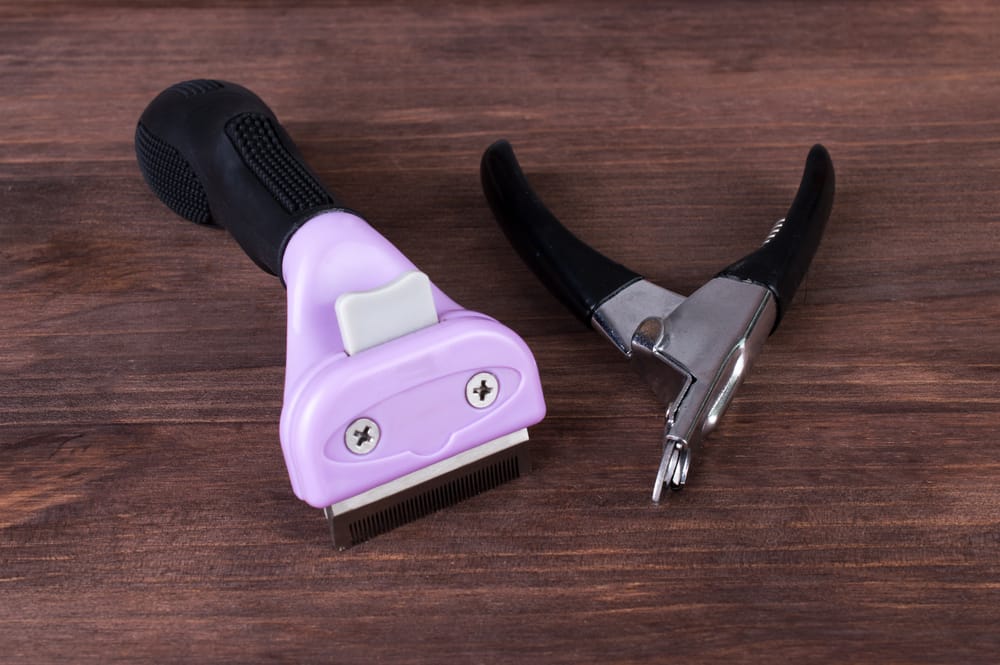If you want your dog to maintain a coat that is shiny and tangle-free, regular coat grooming is necessary. Also, when you groom your dog frequently, it enables you to check for things such as infestations and various skin issues, enhancing their general hygiene. You also create an opportunity to bond more with your pet. Regular grooming is important even if your dog has a short, low-maintenance coat; every dog requires frequent brushing, nail trimming, and bathing.
Favorite Tools – Ruff ‘n Ruffus Deshedding Brush + Free Bonus Nail Clippers
While Primped Pooches is available for scheduling appointments with one of our expert dog groomers you can also handle your pet’s grooming at home without the assistance of a professional groomer, or at the very least handle some of the grooming basics in between professional grooming appointments. You can come up with an at-home grooming routine by following the tips below.
1. Brush your dog’s coat frequently
Brushing your canine friend’s coat on a regular basis will help to prevent matting. Brushing is not only for certain types of dogs; it should be done regardless of breed. However, how often you brush the coat generally depends on the length and texture of the dog’s coat. For instance, if you have a longhaired breed such as a golden retriever, more frequent brushing is needed (once every week, or even once every couple of days). On the other hand, if you own a shorthaired breed such as a greyhound, a good brushing is required every other week.
2. Trim the dog’s hair with caution
Some dog owners are a bit hesitant when it comes to trimming their pet’s hair. That is why they prefer taking their pets to a groomer to handle the job. However, even if you are not an expert, it is possible to trim overgrown hair around your canine friend’s paws and eyes in-between the professional grooming appointments.
Trimming the hair around your pet’s eyes is important because it helps to prevent the overgrown hair from obstructing its vision and rubbing against your pet’s eyes, which can cause damage to the eyes. The trick is to wait until your pet is calm, and it is also best to trim the overgrown hair when your dog is lying down. Moving calmly and slowly, trim the overgrown hair, ensuring that you use extra caution when the scissor blades are close to your dog’s skin. After you have finished, remember to reward your pet for being so calm. When your dog is not calm, avoid trimming overgrown hair, especially near areas such as the eyes. There are certain areas, such as inside the dog’s ears that are best handled by a professional groomer.
3. Trim the dog’s nails
It is also possible to safely trim your pet’s nails at home. Usually, you know that it is time to trim the nails when they start clicking on the hard floors in your house. Overly long nails can cause some discomfort to your dog. In order to trim your dog’s nails, you need dog nail clippers or scissors and a flashlight (for dark nails). Before you start trimming the nails, make sure that you define the cutting range first. Determining the cutting range is important because dog nails are supplied with blood. If you clip the nail too high up, it may cause a lot of pain to your dog. Therefore, the ideal cutting range ends just before the blood supply to the nails.
When it comes to the actual trimming, make sure that your canine friend is in a relaxed position and trim by taking little steps at a time; there is no need to rush. You can also use treats to keep your dog calm during the trimming process. At the end of the process, if you don’t see any blood and your dog is behaving normally, it means you have done a great job.
Although you can always schedule grooming appointments with a professional dog groomer, it is possible to groom your canine friend at home. You just have to know how to go about it, and also know your limits. There are certain dog grooming techniques that can be easily done at home such as those discussed above, and there are those dog grooming techniques that are best left to the professionals.





